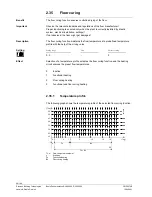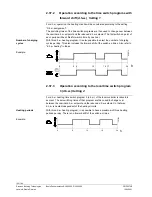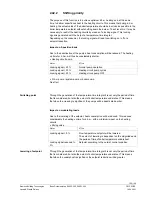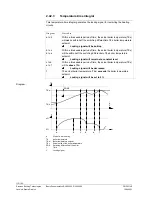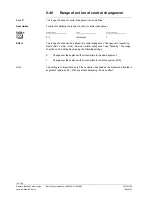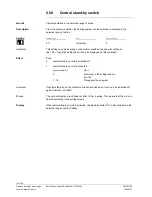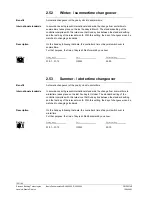
109/184
Siemens Building Technologies
Basic Dokumentation RVA63.280, RVA53.280
CE1P2374E
Landis & Staefa Division
19.04.2001
2.42.2
Shifting priority
The purpose of this function is to achieve optimum d.h.w. heating and, at the same
time, to deliver superfluous heat to the heating circuits. This means that during d.h.w.
heating, the actual value of the boiler temperature should be as close as possible to the
boiler temperature setpoint without shutting down the burner. To achieve this, it may be
necessary to restrict the heating circuits by means of a locking signal. This locking
signal is generated with the help of a temperature-time integral.
Depending on the consumer, the locking signal will lead to switching on / off or a
setpoint reduction.
Impact on 2-position loads
Due to the deactivation of the pumps, heat consumption will be reduced. The heating
up time for d.h.w. will thus be considerably shorter.
•
Heating circuit pump:
Status
Effect
Locking signal = 20 %
Normal pump operation
Locking signal > 20 %
Heating circuit pump cycles
Locking signal = 93 %
Heating circuit pump OFF
•
D.h.w. pump / system pump or boiler pump:
No effect
Through the generation of the temperature-time integral it is not only the period of time
that is considered, but also the extent of boiler temperature undershoot. This means
that when the crossing is significant, the pumps will be deactivated earlier.
Impact on modulating loads
Due to the lowering of the setpoint, heat consumption will be reduced. This reduces
considerably the heating up time for d.h.w., with a minimum impact on the heating
circuits.
•
Mixing valve:
Status
Effect
Locking signal > 0 %
Flow temperature setpoint will be lowered.
The extent of lowering is dependent on the magnitude and
the period of time of boiler temperature undershoot.
Locking signal reduced to
0 %
Setpoint according to the normal control condition
Through the generation of the temperature-time integral it is not only the period of time
that is considered, but also the extent of boiler temperature undershoot. This means
that when the undershoot is significant, the setpoint reduction will be greater.
Switching point
Lowering of setpoint




